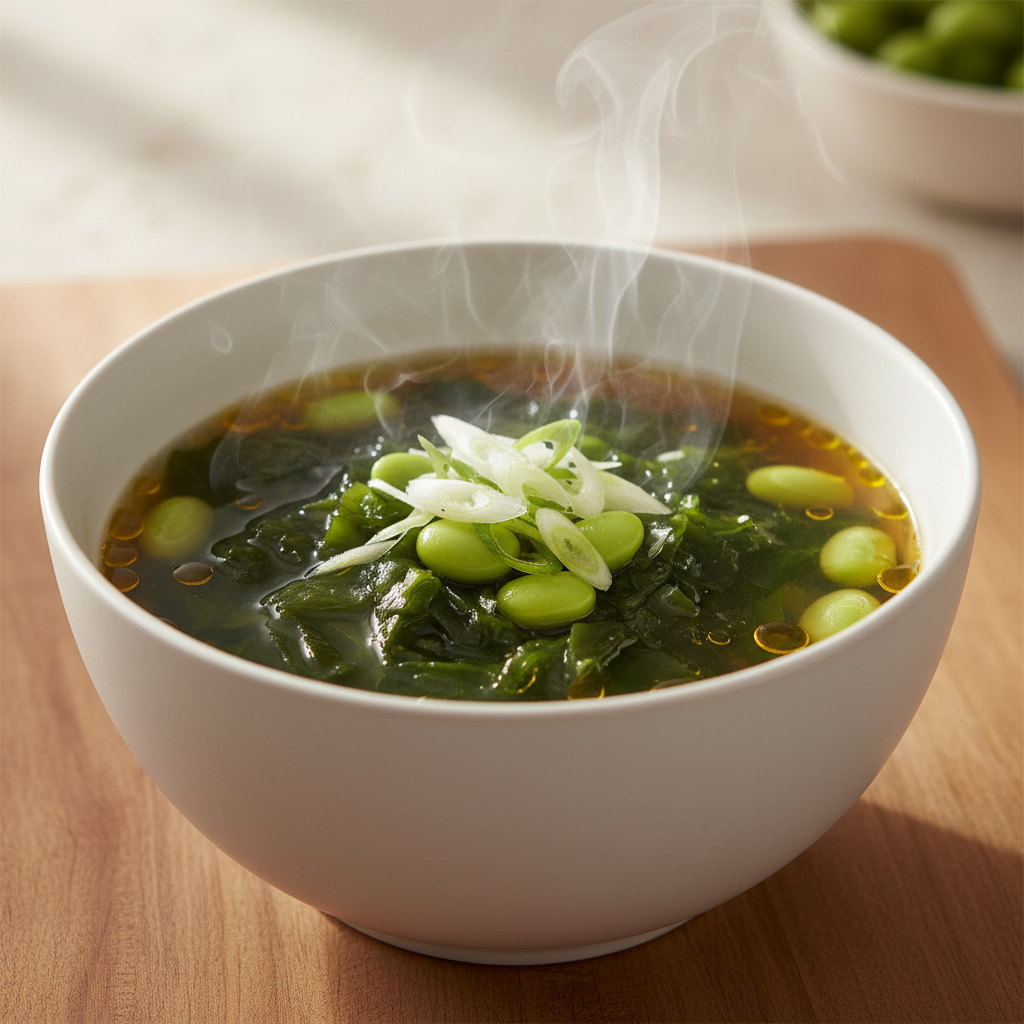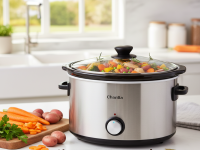Hey there, fellow food adventurers! Are you constantly on the lookout for meals that are not just good for you, but also genuinely delicious and satisfying? I know I am. It’s a never-ending quest, right? Especially when you’re trying to keep things light and healthy without feeling like you’re missing out on flavor. Well, let me tell you, I’ve found my holy grail in the form of a simple yet incredibly nourishing bowl: my low-calorie seaweed and edamame soup. And today, I’m thrilled to share my personal journey and tried-and-true recipe with you.
This isn’t just a recipe; it’s a game-changer that has become a staple in my kitchen. It’s the kind of meal I crave on a chilly evening, a quick lunch when I’m short on time, or a comforting starter to a bigger meal. If you’re skeptical about seaweed or thinking ‘soup can’t be *that* exciting,’ stick with me. I promise, by the end of this, you’ll be itching to whip up a batch yourself!
Why This Soup Became My Healthy Obsession
My journey to this soup started quite by accident. I was exploring more plant-based and Asian-inspired cuisine, intrigued by the umami flavors and nutrient density. I’d always enjoyed miso soup, but wanted something even lighter and more substantial. That’s when I started experimenting with wakame seaweed and edamame – two powerhouses of nutrition that completely transformed my perspective on simple broths.
What makes this particular combination so special for me? Let me break it down:
-
The Power of Seaweed: My Umami Secret
I distinctly remember my first proper introduction to wakame seaweed in a soup. It wasn’t just healthy; it was *flavorful*. Wakame, a type of edible brown seaweed, rehydrates into silky, tender strands that add an incredible depth of umami to the broth. For me, it’s not just about the taste; it’s about the incredible nutritional punch. Seaweed is a fantastic source of iodine, which is crucial for thyroid health, and it’s packed with other minerals like calcium, magnesium, and iron. Plus, it’s super low in calories and helps me feel full, which is a big win when I’m managing my intake.
-
Edamame’s Green Goodness: The Satisfying Bite
Before adding edamame to my soup, I used to snack on it roasted. The crunch and the slightly sweet, nutty flavor were addictive. But in soup? It adds a wonderful texture contrast to the soft seaweed and a significant protein boost. Those bright green beans are little nutritional bombs, loaded with plant-based protein, fiber, and essential vitamins like folate and Vitamin K. For someone like me who needs to feel satisfied after a meal, the protein and fiber in edamame are absolute lifesavers. They keep me feeling fuller for longer, preventing those pesky mid-afternoon snack attacks.
-
The Low-Calorie Magic: Guilt-Free Indulgence
This is where this soup truly shines for me. I’m always looking for ways to enjoy hearty, flavorful meals without derailing my calorie goals. This soup fits the bill perfectly. It’s incredibly flavorful and satisfying, yet surprisingly low in calories. It’s comforting without being heavy, which means I can enjoy a generous bowl without any guilt. It’s a fantastic option for a light dier, a wholesome lunch, or even a healthy snack.
-
Flavor Profile: A Symphony of Savory and Fresh
For me, the perfect soup balances several flavors. This seaweed and edamame soup achieves a beautiful harmony. The broth, rich with ginger, garlic, and a hint of soy, provides a savory base. The rehydrated wakame adds its unique umami, while the edamame brings a delicate sweetness and a pleasant chew. A touch of sesame oil at the end ties everything together with a nutty aroma. It’s incredibly fresh and vibrant, a truly delightful experience for the taste buds.
Gathering Your Ingredients: My Essential Shopping List
One of the best things about this soup is how simple the ingredients are. You probably have most of them in your pantry already! Here’s what I always make sure to have on hand:
- Dried Wakame Seaweed: I usually buy a large bag from an Asian grocery store or online. It lasts forever and a little goes a long way. Make sure it’s good quality; I look for vibrant green, thin strands.
- Shelled Edamame: Frozen, shelled edamame is my go-to for convenience. No fuss, no shelling! Just thaw it slightly or add directly to the soup.
- Vegetable Broth: Opt for a low-sodium vegetable broth. It gives you more control over the saltiness, which is important when adding soy sauce later. I’ve found that a good quality broth really makes a difference to the overall flavor.
- Fresh Ginger: Absolutely non-negotiable for me! Freshly grated ginger adds a wonderful warmth and zing. Don’t use dried ginger powder here; the fresh stuff is key to that vibrant taste.
- Fresh Garlic: Minced garlic provides a lovely aromatic base. Again, fresh is best!
- Low-Sodium Soy Sauce: This is my primary seasoning. Using low-sodium allows me to adjust the saltiness without overdoing it. Tamari is a great gluten-free alternative.
- Toasted Sesame Oil: Just a drizzle at the end! This adds an incredible nutty aroma and depth of flavor that really elevates the soup.
- Green Onions (Scallions): For garnish and a fresh, mild oniony bite. I always chop extra because I love them!
- Optional: A pinch of red pepper flakes if you like a little heat, or a squeeze of lime juice for extra brightness.
My Step-by-Step Guide to Soup Perfection
Ready to make this magic happen? Here’s exactly how I prepare my favorite low-calorie seaweed and edamame soup. It’s incredibly straightforward, even if you’re a begier cook:
-
Rehydrate the Wakame:
First things first, I take about 1/4 cup of dried wakame and place it in a bowl. Then, I pour enough warm water over it to fully submerge. It’s amazing how quickly it expands and softens! I let it sit for about 5-10 minutes. Once it’s soft, I drain it thoroughly and give it a quick chop into smaller, more manageable pieces, about 1-inch long. This makes it easier to eat and ensures it’s evenly distributed in the soup.
-
Sauté the Aromatics:
In a medium pot, I add a tiny splash of toasted sesame oil (or even just a little water if I’m being super strict with calories) over medium heat. Once warm, I add my minced fresh ginger (about 1 tablespoon) and minced garlic (2-3 cloves). I sauté them for just about 1 minute until fragrant. Be careful not to burn the garlic; we want a gentle aroma, not a bitter taste.
-
Build the Broth:
Next, I pour in about 4 cups of low-sodium vegetable broth. I bring the broth to a gentle simmer. Once it’s simmering, I add 1 cup of shelled edamame (if frozen, no need to thaw completely, it will cook right in the broth). I let it simmer for about 3-5 minutes, just until the edamame is tender-crisp and bright green.
-
Add the Star Ingredient:
Now, it’s time for the rehydrated and chopped wakame seaweed. I stir it into the simmering soup. Since the wakame is already soft, it only needs to heat through for about 1-2 minutes. You don’t want to overcook it, or it can get a bit mushy.
-
Season and Finish:
This is where I fine-tune the flavor. I stir in 2-3 tablespoons of low-sodium soy sauce. I always start with 2 and taste, then add more if needed. Finally, I remove the pot from the heat and stir in about 1/2 teaspoon of toasted sesame oil. This really brings out the nutty aroma and adds a lovely richness without extra calories. I also sometimes add a pinch of red pepper flakes if I’m in the mood for a bit of warmth.
-
Serve and Garnish:
I ladle the hot soup into bowls and garnish generously with freshly chopped green onions. Sometimes, if I’m feeling fancy, I’ll sprinkle a few toasted sesame seeds on top. Enjoy it immediately!
Making It Your Own: My Customization & Serving Suggestions
While the basic recipe is fantastic, I often tweak it based on what I have on hand or what I’m craving. Here are a few ways I like to customize my soup:
- Boost the Protein: If I want a heartier meal, I’ll add cubed firm tofu (marinated and pan-fried beforehand for extra flavor), or even some shredded cooked chicken if I have leftovers.
- Veggies Galore: Sometimes I’ll throw in other quick-cooking vegetables like sliced mushrooms, spinach (add at the very end to just wilt), or even a handful of bean sprouts for extra crunch.
- Spice It Up: A dash of Sriracha or a spoonful of gochujang (Korean chili paste) can add a fantastic spicy kick. I’ve also experimented with a tiny bit of white miso paste stirred in at the very end (after removing from heat) for an extra layer of umami.
- Serving Suggestions: This soup is wonderful on its own, but I often pair it with a small side of brown rice for a more complete meal. It also makes a great light appetizer before a sushi dier or a fresh salad.
- Batch Cooking: This soup is great for meal prep! I often make a larger batch and store it in airtight containers in the fridge for up to 3-4 days. It reheats beautifully on the stovetop or in the microwave. The flavors actually meld even more overnight.
The Real-World Impact: How This Soup Transformed My Meals
Honestly, discovering and refining this low-calorie seaweed and edamame soup has been a game-changer for my eating habits. It’s given me a reliable, delicious, and incredibly healthy option that I genuinely look forward to. I’ve noticed a difference in how I feel – lighter, more energetic, and consistently satisfied after meals. It’s living proof that eating healthily doesn’t have to mean sacrificing flavor or feeling deprived. It can be easy, accessible, and deeply enjoyable.
For me, this soup isn’t just about the calories; it’s about incorporating nutrient-dense ingredients into my diet in a way that feels natural and delightful. It’s about nourishing my body with wholesome goodness while still indulging in incredibly delicious flavors. And that, my friends, is a win-win in my book.
So, if you’re looking for a simple, healthy, and incredibly flavorful recipe to add to your rotation, please give my low-calorie seaweed and edamame soup a try. I’m confident you’ll love it as much as I do. Happy sipping!




